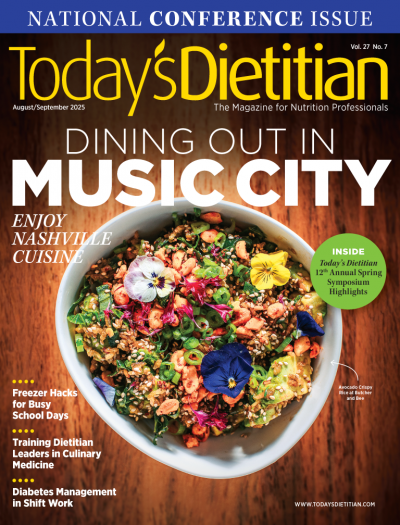By Bryan Roof, RD, LDN
Today’s Dietitian
Vol. 15 No. 11 P. 74
The first time I had pickled watermelon rind was on a tiny sailboat with a broken horn on a suddenly very foggy day in Boston Harbor surrounded by much larger boats. We floated along somewhat aimlessly—and a little dangerously.
With the weather basically paralyzing our movement in any direction, we did what any band of would-be chef/pirates would have done: dropped anchor and had lunch. Among the assortment of cheese, charcuterie, crunchy bread, and wine, there was pickled watermelon rind. I was intrigued by the concept and the thriftiness of it, and vowed that when and if I made it back to land, I’d figure out a recipe of my own. It’s all so dramatic.
The practical benefit of pickling is that you can extend the shelf life of produce for three days, a week, a month, or even longer under the right conditions.* This means that the beautiful radishes, cucumbers, peppers, and carrots you harvest at the height of summer still can be eaten long after they’re no longer fresh from the garden—albeit slightly altered but no less enjoyable. What pickled produce may lack in crunch, it makes up for with a unique crisp-tender texture and sweet-sour appeal that can accompany various foods.
The basic components of pickling are simple: vinegar, water, sugar, and salt, which constitute the brine; fresh produce; and clean jars or bowls in which to combine the brine and produce. The type of vinegar comes down to a matter of preference, but I find unfiltered cider vinegar to have nice acidity and flavor.
While methods may vary, I typically begin by filling a jar (or more, if you want) with the vegetables I intend to pickle along with any desired spices or herbs. After bringing the brine to a boil on the stovetop, I pour it into the jar and let it sit, uncovered, until it reaches room temperature. Then I affix the lid and refrigerate the jar for at least two hours or up to two days before sampling. Some recipes instruct you to blanch the vegetables first, but I prefer to skip this step because I find the boiling brine to be enough heat to soften the vegetables, and I prefer that they retain at least some of their original crunch in the end.
It’s been five years since the fog lifted on that sailboat, but the memory of that pickled watermelon rind still is as sweet (and vinegary and salty) as the homemade jar I’m staring at now.
* Consult the USDA’s recommendations and precautions for home canning at http://nchfp.uga.edu/publications/publications_usda.html.
— Bryan Roof, RD, LDN, is a chef, dietitian, and food writer living in Boston. Follow him on Twitter @bryanroof.
Pickled Watermelon Rind
These “fresh” pickles will keep, refrigerated, for up to 2 weeks or longer.
Makes approximately 3 quarts
Ingredients
3 cups cider vinegar
3 cups water
1 1/2 cups granulated sugar
1/4 cup fine sea salt
1/2 medium watermelon
1 tsp coriander seeds
1 tsp whole black peppercorns
1 tsp yellow mustard seeds
Clean jars with lids
Directions
1. Combine the vinegar, water, sugar, and salt in a large saucepan and bring to a boil.
2. Meanwhile, using a vegetable peeler, remove the green skin from the watermelon. With a thin-bladed knife, remove and reserve the white rind, taking care to avoid the pink fruit. Cut the rind into 2- by 1/2-inch strips. (Set aside the fruit for another use.)
3. Fill the jars with the watermelon rind, and divide the spices among the jars. Pour the hot brine into the jars, leaving 1 inch of headspace. Let cool to room temperature. Affix the lids, and then refrigerate for at least two hours or up to two days before sampling.
Nutrient Analysis per serving
Calories: 20; Total fat: 0 g; Sat fat: 0 g; Trans fat: 0 g; Cholesterol: 0 mg; Sodium: 170 mg; Total carbohydrate: 5 g; Fiber: 0 g; Sugars: 5 g; Protein: 0 g (Note: These numbers are very approximate and based on commercially available pickles.)


